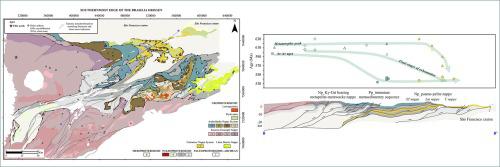Precambrian Research ( IF 3.8 ) Pub Date : 2021-02-12 , DOI: 10.1016/j.precamres.2021.106115 Alice Westin , Mario C. Campos Neto , Maria Helena B.M. Hollanda , Claudio A. Salazar-Mora , Gláucia N. Queiroga , Gabriella L. Frugis , Marco Paulo de Castro

|
In this contribution we investigate the exhumation T-t path of a nappe system located in the southernmost edge of the Brasília Orogen, southeast Brazil, developed during the West Gondwana assembly. The allochthons represent an inverted metamorphic pile of nappes and were deformed during the collision between the Paranapanema (active margin) and São Francisco (passive margin) paleocontinents. The nappe system comprises UHT rocks of a magmatic arc root (upper Socorro-Guaxupé Nappe), the accretionary wedge – foreland units metamorphosed under high-pressure conditions (intermediate Andrelândia Nappe System) and the lower passive margin metasedimentary sequences (the high-pressure Carrancas Nappes System and the Lima Duarte Nappe). New U-Th-PbT in monazite and 40Ar/39Ar in hornblende, biotite and muscovite ages combined with previously published data indicate different patterns of cooling for each allochthon. The upper nappes register a collision to exhumation/cooling path, from 630–625 Ma to 590–580 Ma, which indicates that the geological process active during the West Gondwana amalgamation involved fast exhumation tectonics. Cross-sections along the main transport direction of the nappes indicate a progressive decrease of metamorphic age peaks (630–625 Ma to 590–570 Ma) and 40Ar/39Ar cooling ages (600 Ma to 540 Ma) from the internal regions (SW) to the front (NE) of the nappe system, which indicate that the propagation of the nappe pile advanced progressively from the upper to the lower nappes.
中文翻译:

西贡多瓦纳合并期间建造的新元古代推覆系统的快速发掘模式:热年代学的见解
在这项研究中,我们研究了西贡多瓦纳议会期间在巴西东南部巴西利亚造山带最南端的一个推覆系统的尸体Tt路径。异位体代表一堆倒置的变质的尿布,并在帕拉那帕内玛(主动边缘)和圣弗朗西斯科(被动边缘)古大陆之间的碰撞过程中变形。推覆系统包括岩浆弧根的UHT岩石(Socorro-Guaxupé纳珀上部),在高压条件下变质的增生楔形前陆单元(中层安德雷纳迪亚推覆系统)和下部被动边缘变质沉积层序(高压ran肉)纳普斯系统和利马·杜阿尔特纳普)。独居石和40 Ar / 39中的新型U-Th-Pb T角闪石,黑云母和白云母年龄的Ar与先前发表的数据相结合,表明每种异源石的冷却方式不同。上部的尿布与发掘/冷却路径发生了碰撞,从630-625 Ma到590-580 Ma,这表明在西贡多瓦纳合并期间活跃的地质过程涉及快速的发掘构造。沿尿布主输送方向的横截面表明,内部区域的变质年龄峰(630-625 Ma至590-570 Ma)和40 Ar / 39 Ar冷却年龄(600 Ma至540 Ma)逐渐减少( SW)到尿布系统的前部(NE),这表明尿布堆的传播是从上层到下层的尿布逐渐进行的。



























 京公网安备 11010802027423号
京公网安备 11010802027423号